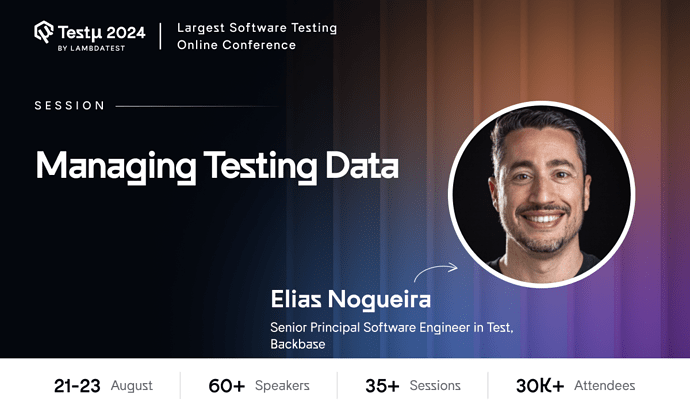 Ever struggled with troubleshooting issues tied to data usage in your logs? It’s time to rethink your approach to testing data! Developers often rely on hard-coded or random data, but real-world scenarios demand more sophisticated solutions.
Ever struggled with troubleshooting issues tied to data usage in your logs? It’s time to rethink your approach to testing data! Developers often rely on hard-coded or random data, but real-world scenarios demand more sophisticated solutions. 
Join Elias, Senior Principal Software Engineer and Java Champion, for a deep dive into effective testing data management. Discover two essential approaches:
-
Test Data Factory: Learn to leverage the Factory Pattern and the DataFaker library to generate reliable and understandable data, giving you better control and quicker bug detection.
-
Data-Driven Testing: Explore JUnit 5’s versatile capabilities, including value source, internal method source, external method source, argument provider, and CVS source, to streamline your tests and reduce code complexity.
Elias will guide you through practical examples in a Spring Boot application, enhancing your ability to manage testing data efficiently. 
Don’t miss this chance to refine your testing strategies and boost your debugging prowess!
Still not registered? Secure your spot now: Register Now!
Already registered? Drop your questions in the thread below 
Hi there,
If you couldn’t catch the session live, don’t worry! You can watch the recording here:
Here are some of the Q&As from this session:
How select test data especially when testing LLM models ?
Elias Nogueira: When testing LLM models, it’s crucial to select a diverse set of test data that covers various edge cases, language styles, and contexts. The test data should include examples that challenge the model’s understanding, reasoning, and generation capabilities. Additionally, using real-world examples alongside synthetically generated data can help in evaluating the model’s robustness and accuracy.
The examples for generating test data with Faker are great! Would you recommend to generate the test data only once so that tests are predictable or is it acceptable to have different test data on every test run?
Elias Nogueira: Whether to generate test data only once or on every test run depends on your testing goals. Generating test data once makes tests predictable and easier to debug, which is useful for regression testing. However, generating different test data on every run can be beneficial for uncovering edge cases and ensuring your tests cover a wider range of scenarios. Both approaches have their merits and can be used in conjunction depending on the context.
How do you handle orphaned test data in the case of unexpected failures?
Elias Nogueira: To manage orphaned test data resulting from unexpected failures, it’s important to implement cleanup mechanisms that trigger even when tests fail. This can be done by using teardown methods or hooks that ensure any test data created during a test run is removed, regardless of the test outcome.
How do we elevate Data faker to godlike level?
Elias Nogueira: To take Data Faker to the next level, focus on enhancing its flexibility and realism. This includes customizing the generated data to closely match the production data, adding support for complex data structures, and integrating it with machine learning models to generate context-aware data. Additionally, automating the creation of data scenarios that mimic real-world conditions can significantly elevate the tool’s utility and effectiveness in testing.
Here are the Unanswered Questions
How do you ensure that sensitive information in test data is protected from unauthorized access?
Can we generate Synthetic data (SIP/RTP)using this tool?
Can DataFaker be used outside of the JVM ecosystem say to JSON files for ease of import into other systems?
What are some advantages of using DataFaker to generate test data?
As data is generated randomly we also will need to log the Test data for investigations
What best practices should be followed when analyzing log files to troubleshoot data-related issues in real-world applications?
What approach should we follow when test data keeps changing very frequently?
Are there occasions where managing and storing test data in an immutable and air-gapped environment desirable?
Can we generate multiple sets of data using Faker?
How does data-driven testing reduce code complexity and execution time?
Chaos engineering is on my radar so I wonder if DataFaker could be a good fit for more demanding chaos engineering tests.
What happens if the password field has a fixed number of characters with mandatory characters?
If we have 3rd party test data, can we use Faker too? Thanks in advance
To protect sensitive information in test data:
-
Data Masking: Replace sensitive data with anonymized data in test environments.
-
Encryption: Ensure that all sensitive data is encrypted both in transit and at rest.
-
Access Control: Implement role-based access control (RBAC) to limit who can view or manipulate test data.
![]() Ever struggled with troubleshooting issues tied to data usage in your logs? It’s time to rethink your approach to testing data! Developers often rely on hard-coded or random data, but real-world scenarios demand more sophisticated solutions.
Ever struggled with troubleshooting issues tied to data usage in your logs? It’s time to rethink your approach to testing data! Developers often rely on hard-coded or random data, but real-world scenarios demand more sophisticated solutions. ![]()
![]()
![]()

